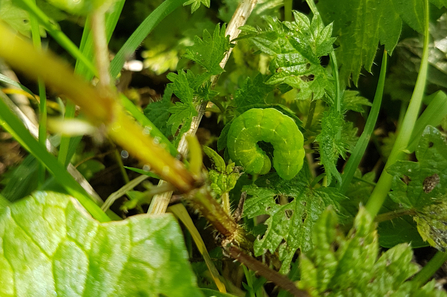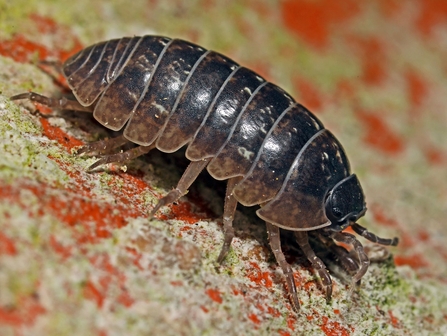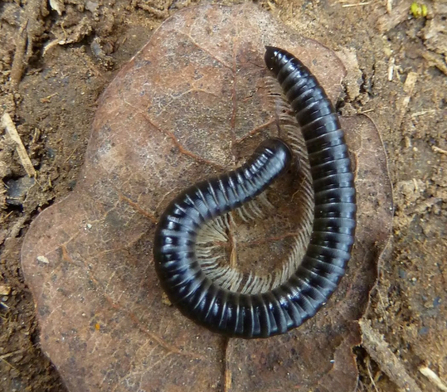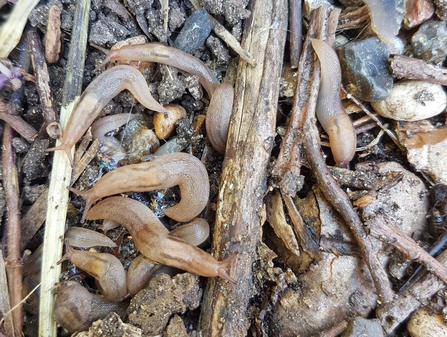Like many this year, I embarked with renewed enthusiasm for vegetable gardening. Having neglected it for several years, no dig was not an option. Instead I tackled the extracting nettle roots and bind weed as best I could. As I turned the soil, I discovered various grubs, previously dismissed or fed to my hens as potential pests. This time I took a little more effort to investigate if they really were waiting to pounce and devour my vegetable plants. I was spurred on by reading that in a study of urban green spaces by Leeds, Edinburgh, Reading and Bristol Universities in 2019, residential gardens and allotments were identified as ‘pollinator hotspots’ in comparison to the other green spaces surveyed.*
Soil Invertebrates, and their ecological role in the garden
7-spot ladybird larvae - Martin Smith

Green caterpillar - Cathy Smith
My first candidate was a luminescent green caterpillar, most likely the caterpillar of angle shades. Well here we have a dilemma, many moths as adults are helpful pollinators in the garden, whilst their caterpillars munch at roots or leaves. The majority don’t reach significant numbers on a single plant species to make a real nuisance of themselves, in the case of the bright green caterpillar, it was returned to its hidey hole to carry on its caterpillar business. That is all assuming that, like so many caterpillars, it doesn’t end up providing breakfast for resident garden birds, maybe that song thrush which has been singing loudly from our TV aerial. Other caterpillars similarly un-earthed, included a ghost moth caterpillar.

Pill woodlouse - Martin Smith
Pill bugs, cheesey-bugs, wood-pigs, colloquial names for woodlice, what harm have they ever done? Well, a quick google search finds various offers of toxic chemicals for ridding them from your garden. We certainly should not be attempting to eradicate them. Primarily they eat dead and decaying material, so sadly for woodlice they have been wrongly incriminated whilst helpfully moving in to clear up the damage done by other mechanisms. Yet, Medieval people revered them as a cure all and carried them about like paracetamol is today. Five species of woodlice account for three quarters of the UK records; pygmy, striped, shiny, rough and pill woodlice. Another species I found in my vegetable garden is the ant woodlouse, a tiny white woodlouse, blind and with a, yet undefined, relationship with ants.

Millipede - Joy Russell
A yellow, shiny beetle larvae, six small legs at the head end, a segmented body, all characteristic of wire worms. This soil insect will be familiar to many gardeners, in number they are reputed to damage plant roots and potatoes. Hand removal is possible or maybe try a cut potato as a lure than remove. It appears nothing is straight forward though, of the 73 British species, half are potential pests of crops, the others are potentially beneficial eating decaying leaf litter or even predaceous. But what of the adult, a click beetle? Adult click beetles are rather good fun, with an escape tactic of propelling themselves into mid- air whilst accompanied by an audible click.
Then, there was a centipede too fast to catch, and a millipede unwilling to unfurl. The common centipede uses modified legs to inject toxin into its prey. If you can get a close enough look, centipedes have one pair of legs per segment, millipedes have two pairs of legs per segment. Most millipedes are nature's recyclers, eating decaying material. Neither are of concern to a vegetable grower, rather an aid to a healthy plot.
Lurking beneath a flower pot, the black clock beetle, Pterostichus madidus, is distinctive enough to identify. It will eat vegetable matter but UK Beetles assure us that it is primarily a scavenger and predator, feasting on worms, small slugs and insect larvae.
Ah, the tell-tale holes of pea weevil on the broad beans but insufficient to prevent the beans growing. Another challenge, black aphids arrive, I am now just waiting for the ladybird calvary to turn up, if impatience gets the better of me, a soapy rag might be called for. Yet somehow with all that challenge, the broad beans continue little checked, if not award winning. As May turns to June the nettles at the edge of the vegetable garden are now speckled with ladybird pupae, not long to wait now for the ladybirds to emerge.
As the vegetable garden progresses, the end yet to be tended bursts into flower, first a huge clump of borage which flowers relentlessly to the joy of the bumble bees. As the borage begins to seed, hogweed takes over, attracting a host of pollinators such as hoverflies. I carefully leave as many as I can whilst shoe-horning the winter squash plants into place.
A study published in May this year demonstrated that planting borage amongst strawberry plants increased the number and size of strawberries. A few favourite pollinators flowers in the vegetable garden or allotment, apart adding a welcome distraction from weeding, is going to bring benefits to the ultimate harvest **

Common carder bee on borage - Chris Gomersall/2020VISION
Although only a minority of invertebrates are serious pest species, a few can cause the organic gardener real cause for concern.
Slugs are one of the most notorious pests, but of course they are a diverse group and include the spectacular looking leopard slug, Limax maximus which apart from eating decaying vegetation eats other slugs. A huddle of slugs around a rotting potato, drew me to look more closely and indeed turned out to be a less welcome resident, the vulgar slug Ambiogolimax valientanus, a non-native species with a capacity to breed rapidly, oust native slugs and a pest of greenhouse plants. Following a rainy downpour, it will definitely time to go out with a torch to remove these and any grey field slugs, Deroceras reticulatum or garden snails, Cornu aspersum. Just remember, before you are tempted to move them to a nearby green space, garden snails have a good homing instinct.

Vulgar slugs - Cathy Smith
Until now, the evidence for using French marigolds as a companion plant to protect from greenhouse white fly, Trialeurodes vaporariorum, has been more anecdotal, but research from Newcastle University found that marigold plants do repel white fly. The effect is seen when marigolds are planted before the white fly numbers build up. The research has led to the potential for Limonene, the chemical found in French marigolds and many household cleaners, to control white fly.***
A four year study by the RHS found that ground active invertebrates flourish where there is dense vegetation, especially when the plants were of native or near-native origin. A few bare patches of ground such as those amongst the vegetables might be made use of by spiders and ground nesting bees. They also suggest that is worth considering winter refuges for invertebrates such as evergreen bushes and leaf litter.
My tardiness in clearing the vegetable patch has helped me to recognise the weed seedlings that really do need removing, those which transform into pollinator magnets and to notice the tiny creatures which support the ecology of a healthy vegetable garden or allotment.
Head over to our ‘Wild about gardens’ website (link below) to find out more about celebrating the nature in your garden. You can also take #ActionforInsects and download a free guide here.
*A systems approach reveals urban pollinator hotspots and conservation opportunities. Katherine C. R. Baldock et al. Nature Ecology & Evolution. 2019
**Companion planting to attract pollinators increases the yield and quality of strawberry fruit in gardens and allotments. Ecological entomology. J Griffiths-Lee, E. Nicholls and D Goulson. 2020
*** Companion planting with French marigolds protects tomato plants from glasshouse whiteflies through the emission of airborne limonene. N. Conboy, C Tosh et al. Plos One 2019
